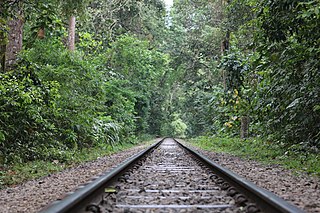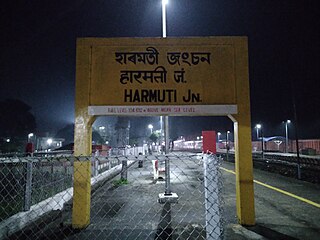Related Research Articles

Northeast India, officially the North Eastern Region (NER), is the easternmost region of India representing both a geographic and political administrative division of the country. It comprises eight states—Arunachal Pradesh, Assam, Manipur, Meghalaya, Mizoram, Nagaland and Tripura, and the "brother" state of Sikkim.

Shillong is a hill station and the capital of Meghalaya, a state in northeastern India. It is the headquarters of the East Khasi Hills district. Shillong is the 330th most populous city in India with a population of 143,229 according to the 2011 census. It is said that the rolling hills around the town reminded the British of Scotland. Hence, they would refer to it as the "Scotland of the East".

The Jaintia Kingdom was a kingdom in present-day some parts of Bangladesh's Sylhet Division, India's Meghalaya state and Nagaon, Morigoan district of Assam. It was partitioned into three in 630 AD by Raja Guhak for his three sons, into the Jaintia Kingdom, Gour Kingdom and Laur Kingdom. It was annexed by the British East India Company in 1835. All the Pnar Rajahs of the Jaintiapur Kingdom are from the Syiem Sutnga clan, a Pnar clan of the Khasi tribe which claims descent from Ka Li Dohkha, a divine nymph.

The Assam earthquake of 1897 occurred on 12 June, in Assam, British India at 11:06 UTC, and had an estimated moment magnitude of 8.2–8.3. It resulted in approximately 1,542 human casualties and caused catastrophic damage to infrastructures. Damage from the earthquake extended into Calcutta, where dozens of buildings were severely damaged, with some buildings partially collapsing. Trembles were felt across India, reaching as far as Ahmedabad and Peshawar. Seiches were also observed in Burma.

Eastern Bengal and Assam was a province of India between 1905 and 1912. Headquartered in the city of Dacca, it covered territories in what are now Bangladesh, Northeast India and Northern West Bengal.
The Ministry of Development of North Eastern Region is a Government of India ministry, established in September 2001, which functions as the nodal Department of the Central Government to deal with matters related to the socio-economic development of the eight States of Northeast India: Arunachal Pradesh, Assam, Manipur, Meghalaya, Mizoram, Nagaland, Tripura and Sikkim. It acts as a facilitator between the Central Ministries/ Departments and the State Governments of the North Eastern Region in the economic development including removal of infrastructural bottlenecks, provision of basic minimum services, creating an environment for private investment and to remove impediments to lasting peace and security in the North Eastern Region.

The Pembroke and Tenby Railway was a locally promoted railway in Pembrokeshire, Wales. It was built by local supporters and opened in 1863. The line, now known as the Pembroke Dock branch line, remains in use at the present day.

Cutch State Railway (CSR) was an isolated 2 ft 6 in (762 mm) narrow gauge railway in Cutch State, one of the princely states allied to Britain in India.

The Howrah–New Jalpaiguri line is a railway line connecting Howrah railway station to New Jalpaiguri Junction railway station in the Indian state of West Bengal. The line continues through North Bengal and western part of Assam to connect with Guwahati. The Naihati–Bandel link allows trains from another terminus Sealdah in Kolkata to use this route. The line uses a major part of the Barharwa–Azimganj–Katwa loop. Many trains use an alternative line between Howrah and New Farakka, via Azimganj. Other parts of West Bengal and Bihar are well-connected to this line. It is under the administrative jurisdiction of Eastern Railway and Northeast Frontier Railway.

The New Jalpaiguri–Alipurduar–Samuktala Road line is a railway line that connects New Jalpaiguri- Siliguri Junction with Alipurduar and Samuktala Road in the Indian state of West Bengal. This railway line passes through the beautiful Doars region, which includes Mahananda Wildlife Sanctuary, Dooars-Terai tea gardens, Sevoke Railway Bridge, River Teesta, River Jaldhaka, River Torsha, Gorumara National Park, Buxa Tiger Reserve, Jaldapara National Park, Chapramari Wildlife Sanctuary, Chilapata Forests, Tunnels, Hills, Valleys etc.

The Akhaura–Kulaura–Chhatak line is a railway line connecting Akhaura and Chhatak, via Kulaura in Bangladesh. This line is under the jurisdiction of Bangladesh Railway
Mahisasan is a border railway station and a defunct railway transit facility point on the India–Bangladesh border in Karimganj district in the Indian state of Assam. The corresponding station on the Bangladesh side is Shahbajpur in Sylhet District. The border station is linked to Karimganj 11 kilometres (6.8 mi) away. The Mahisasan–Shahbajpur route has not been operational since December, 1996 due to lack of traffic.

The New Bongaigaon–Guwahati section of the Barauni–Guwahati line connects New Bongaigaon and Guwahati in the Indian state of Assam.
The Barauni–Guwahati railway line connects Barauni, Saharsa, Purnia and Katihar in the Indian state of Bihar and Bongaigaon, Kamakhya and Guwahati in Assam via Siliguri, Jalpaiguri, Cooch Behar and Alipurduar in West Bengal. It is a linkage of prime importance for Northeastern India with Capital of india.

The Guwahati–Lumding section is a broad-gauge railway line connecting Guwahati and Lumding Junction. The 179-kilometre (111 mi) long railway line operates in the Indian state of Assam. It is under the jurisdiction of Northeast Frontier Railway zone.
Mendipathar railway station is a railway station located in Resubelpara Municipal Board Jurisdiction, Meghalaya, India.

The Rangiya–Murkongselek section is a 450 km (280 mi) long railway line connecting Rangiya in Kamrup district with Murkongselek in Dhemaji district in the Indian state of Assam. The entire section is under the jurisdiction of Northeast Frontier Railway.

Sylhet railway station is a railway station in Bangladesh. There are two types of rail lines in Bangladesh Meter gauge and Broad gauge. This station is connected with meter-gauge link on both sides from Chhatak and Dhaka. This railway station is situated in Sylhet city.
The Tetelia-Byrnihat Line is a planned railway project in Assam and Meghalaya, India, to improve connectivity and boost the region's economy.
References
- 1 2 3 "Cherra Companyganj State Railways, a mountain railway that existed 125 years ago". The Economic Times. 15 March 2012. Archived from the original on 5 March 2016. Retrieved 15 August 2012.
- ↑ Hilaly, Sarah (2007). The railways in Assam, 1885-1947. Varanasi: Pilgrims Pub. ISBN 978-8177694222.
- ↑ Shyam Bhadra Medhi (1978). Transport system and economic development in Assam. Gauhati: Publication Board, Assam. LCCN 81903856.
- ↑ "Railways to make fresh entry into Meghalaya". The Assam Tribune. 27 September 2012. Archived from the original on 24 November 2012. Retrieved 4 August 2013.
- 1 2 3 "Meghalaya fell off Rly map in 1897". The Indian Express. 1 July 2007. Retrieved 4 August 2013.
- ↑ Sessional Papers: Volume 73. Great Britain. Parliament. House of Commons. 1902.
The Cherra-Companyganj State Railway ',(Ab'ssam) was finally closed on the 15th October 1900, as since the earthquake it had ceased to earn working expenses, and the volume of the traffic offering was insufficient to justify the line ...